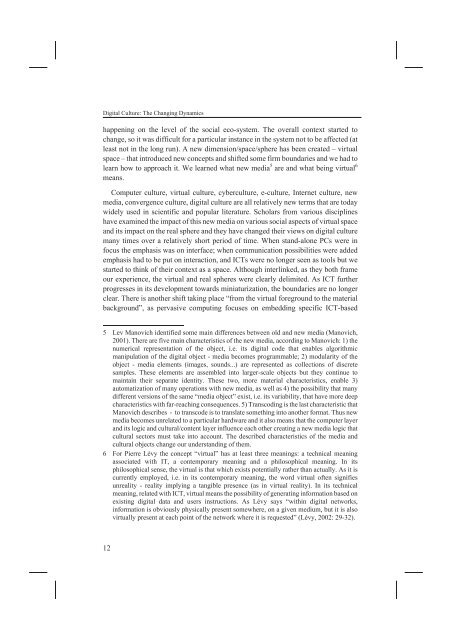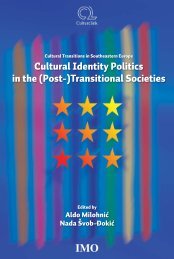D:\Documents and Settings\Ana\My Documents\Biserka-knjiga ...
D:\Documents and Settings\Ana\My Documents\Biserka-knjiga ...
D:\Documents and Settings\Ana\My Documents\Biserka-knjiga ...
Create successful ePaper yourself
Turn your PDF publications into a flip-book with our unique Google optimized e-Paper software.
Digital Culture: The Changing Dynamics<br />
happening on the level of the social eco-system. The overall context started to<br />
change, so it was difficult for a particular instance in the system not to be affected (at<br />
least not in the long run). A new dimension/space/sphere has been created – virtual<br />
space – that introduced new concepts <strong>and</strong> shifted some firm boundaries <strong>and</strong> we had to<br />
learn how to approach it. We learned what new media 5 are <strong>and</strong> what being virtual 6<br />
means.<br />
Computer culture, virtual culture, cyberculture, e-culture, Internet culture, new<br />
media, convergence culture, digital culture are all relatively new terms that are today<br />
widely used in scientific <strong>and</strong> popular literature. Scholars from various disciplines<br />
have examined the impact of this new media on various social aspects of virtual space<br />
<strong>and</strong> its impact on the real sphere <strong>and</strong> they have changed their views on digital culture<br />
many times over a relatively short period of time. When st<strong>and</strong>-alone PCs were in<br />
focus the emphasis was on interface; when communication possibilities were added<br />
emphasis had to be put on interaction, <strong>and</strong> ICTs were no longer seen as tools but we<br />
started to think of their context as a space. Although interlinked, as they both frame<br />
our experience, the virtual <strong>and</strong> real spheres were clearly delimited. As ICT further<br />
progresses in its development towards miniaturization, the boundaries are no longer<br />
clear. There is another shift taking place “from the virtual foreground to the material<br />
background”, as pervasive computing focuses on embedding specific ICT-based<br />
5 Lev Manovich identified some main differences between old <strong>and</strong> new media (Manovich,<br />
2001). There are five main characteristics of the new media, according to Manovich: 1) the<br />
numerical representation of the object, i.e. its digital code that enables algorithmic<br />
manipulation of the digital object - media becomes programmable; 2) modularity of the<br />
object - media elements (images, sounds...) are represented as collections of discrete<br />
samples. These elements are assembled into larger-scale objects but they continue to<br />
maintain their separate identity. These two, more material characteristics, enable 3)<br />
automatization of many operations with new media, as well as 4) the possibility that many<br />
different versions of the same “media object” exist, i.e. its variability, that have more deep<br />
characteristics with far-reaching consequences. 5) Transcoding is the last characteristic that<br />
Manovich describes - to transcode is to translate something into another format. Thus new<br />
media becomes unrelated to a particular hardware <strong>and</strong> it also means that the computer layer<br />
<strong>and</strong> its logic <strong>and</strong> cultural/content layer influence each other creating a new media logic that<br />
cultural sectors must take into account. The described characteristics of the media <strong>and</strong><br />
cultural objects change our underst<strong>and</strong>ing of them.<br />
6 For Pierre Lévy the concept “virtual” has at least three meanings: a technical meaning<br />
associated with IT, a contemporary meaning <strong>and</strong> a philosophical meaning. In its<br />
philosophical sense, the virtual is that which exists potentially rather than actually. As it is<br />
currently employed, i.e. in its contemporary meaning, the word virtual often signifies<br />
unreality - reality implying a tangible presence (as in virtual reality). In its technical<br />
meaning, related with ICT, virtual means the possibility of generating information based on<br />
existing digital data <strong>and</strong> users instructions. As Lévy says “within digital networks,<br />
information is obviously physically present somewhere, on a given medium, but it is also<br />
virtually present at each point of the network where it is requested” (Lévy, 2002: 29-32).<br />
12



